Audiolingual Method vs. Communicative Language Teaching Approaches
VerifiedAdded on 2020/03/16
|7
|1585
|293
Essay
AI Summary
This essay provides a comparative analysis of two prominent language teaching methodologies: the Audiolingual Method and Communicative Language Teaching (CLT). The introduction highlights the importance of foreign language acquisition in today's globalized world and sets the stage for a discussion on effective teaching methods. The essay explores the historical background of both methods, detailing the principles of structural linguistics and behavioral psychology underlying the Audiolingual Method, and the communicative approach. The main features of each method are outlined, including the Audiolingual Method's emphasis on drills and repetition versus CLT's focus on communicative competence and real-world language use. Advantages and disadvantages of each method are discussed, offering a balanced perspective on their respective strengths and weaknesses. The conclusion synthesizes the key differences, emphasizing the importance of understanding the characteristics of each method for effective language instruction. The essay provides a comprehensive overview of both methods, making it a valuable resource for understanding language teaching approaches.
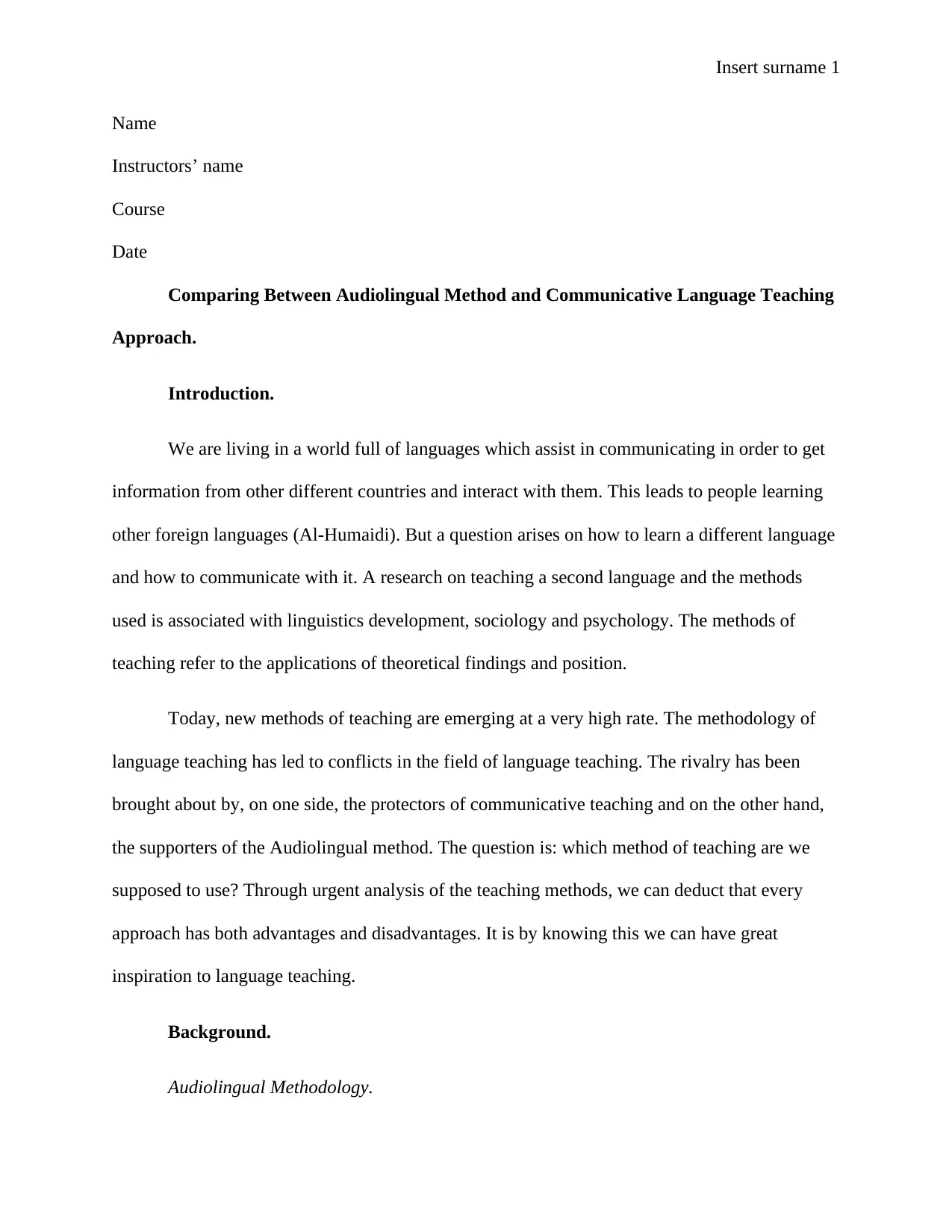
Insert surname 1
Name
Instructors’ name
Course
Date
Comparing Between Audiolingual Method and Communicative Language Teaching
Approach.
Introduction.
We are living in a world full of languages which assist in communicating in order to get
information from other different countries and interact with them. This leads to people learning
other foreign languages (Al-Humaidi). But a question arises on how to learn a different language
and how to communicate with it. A research on teaching a second language and the methods
used is associated with linguistics development, sociology and psychology. The methods of
teaching refer to the applications of theoretical findings and position.
Today, new methods of teaching are emerging at a very high rate. The methodology of
language teaching has led to conflicts in the field of language teaching. The rivalry has been
brought about by, on one side, the protectors of communicative teaching and on the other hand,
the supporters of the Audiolingual method. The question is: which method of teaching are we
supposed to use? Through urgent analysis of the teaching methods, we can deduct that every
approach has both advantages and disadvantages. It is by knowing this we can have great
inspiration to language teaching.
Background.
Audiolingual Methodology.
Name
Instructors’ name
Course
Date
Comparing Between Audiolingual Method and Communicative Language Teaching
Approach.
Introduction.
We are living in a world full of languages which assist in communicating in order to get
information from other different countries and interact with them. This leads to people learning
other foreign languages (Al-Humaidi). But a question arises on how to learn a different language
and how to communicate with it. A research on teaching a second language and the methods
used is associated with linguistics development, sociology and psychology. The methods of
teaching refer to the applications of theoretical findings and position.
Today, new methods of teaching are emerging at a very high rate. The methodology of
language teaching has led to conflicts in the field of language teaching. The rivalry has been
brought about by, on one side, the protectors of communicative teaching and on the other hand,
the supporters of the Audiolingual method. The question is: which method of teaching are we
supposed to use? Through urgent analysis of the teaching methods, we can deduct that every
approach has both advantages and disadvantages. It is by knowing this we can have great
inspiration to language teaching.
Background.
Audiolingual Methodology.
Paraphrase This Document
Need a fresh take? Get an instant paraphrase of this document with our AI Paraphraser
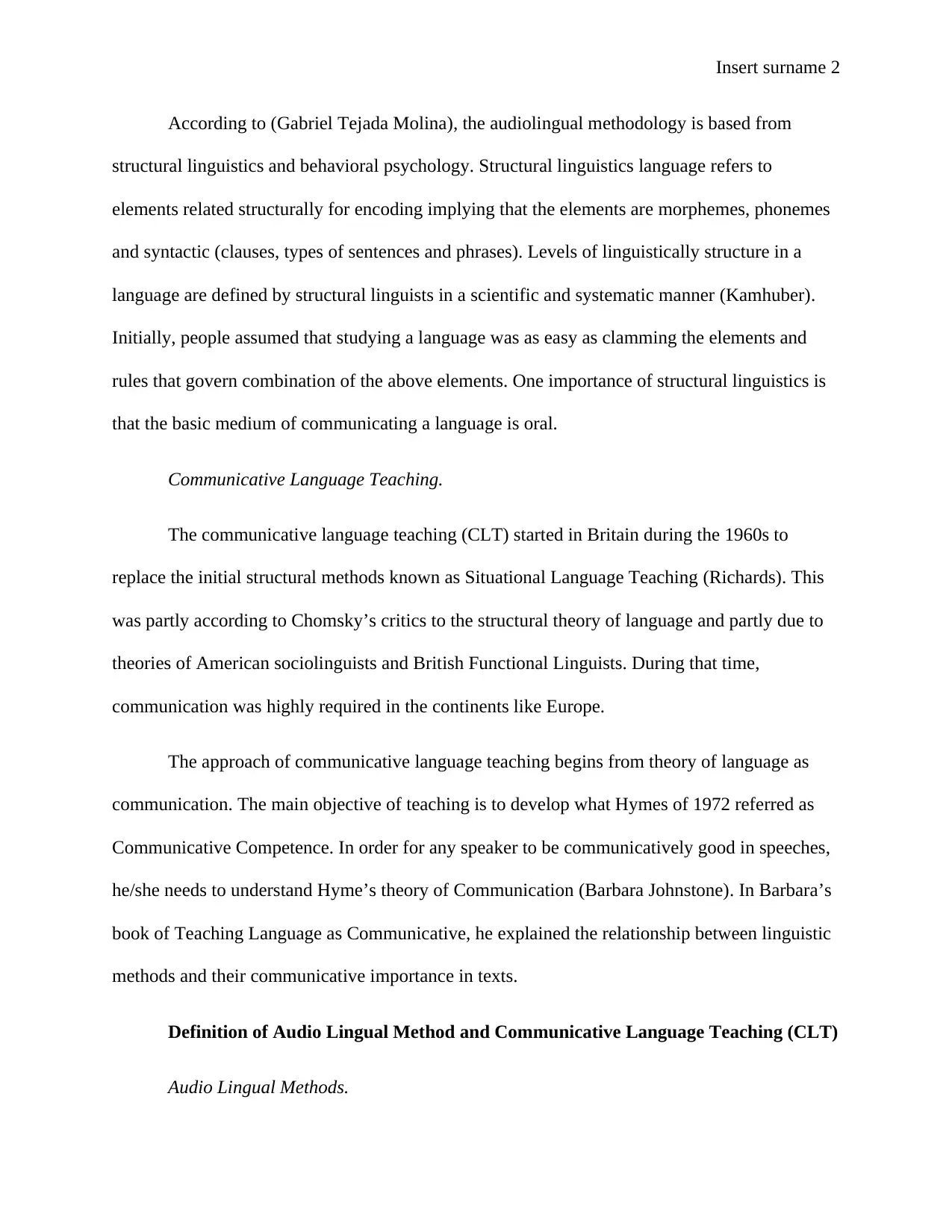
Insert surname 2
According to (Gabriel Tejada Molina), the audiolingual methodology is based from
structural linguistics and behavioral psychology. Structural linguistics language refers to
elements related structurally for encoding implying that the elements are morphemes, phonemes
and syntactic (clauses, types of sentences and phrases). Levels of linguistically structure in a
language are defined by structural linguists in a scientific and systematic manner (Kamhuber).
Initially, people assumed that studying a language was as easy as clamming the elements and
rules that govern combination of the above elements. One importance of structural linguistics is
that the basic medium of communicating a language is oral.
Communicative Language Teaching.
The communicative language teaching (CLT) started in Britain during the 1960s to
replace the initial structural methods known as Situational Language Teaching (Richards). This
was partly according to Chomsky’s critics to the structural theory of language and partly due to
theories of American sociolinguists and British Functional Linguists. During that time,
communication was highly required in the continents like Europe.
The approach of communicative language teaching begins from theory of language as
communication. The main objective of teaching is to develop what Hymes of 1972 referred as
Communicative Competence. In order for any speaker to be communicatively good in speeches,
he/she needs to understand Hyme’s theory of Communication (Barbara Johnstone). In Barbara’s
book of Teaching Language as Communicative, he explained the relationship between linguistic
methods and their communicative importance in texts.
Definition of Audio Lingual Method and Communicative Language Teaching (CLT)
Audio Lingual Methods.
According to (Gabriel Tejada Molina), the audiolingual methodology is based from
structural linguistics and behavioral psychology. Structural linguistics language refers to
elements related structurally for encoding implying that the elements are morphemes, phonemes
and syntactic (clauses, types of sentences and phrases). Levels of linguistically structure in a
language are defined by structural linguists in a scientific and systematic manner (Kamhuber).
Initially, people assumed that studying a language was as easy as clamming the elements and
rules that govern combination of the above elements. One importance of structural linguistics is
that the basic medium of communicating a language is oral.
Communicative Language Teaching.
The communicative language teaching (CLT) started in Britain during the 1960s to
replace the initial structural methods known as Situational Language Teaching (Richards). This
was partly according to Chomsky’s critics to the structural theory of language and partly due to
theories of American sociolinguists and British Functional Linguists. During that time,
communication was highly required in the continents like Europe.
The approach of communicative language teaching begins from theory of language as
communication. The main objective of teaching is to develop what Hymes of 1972 referred as
Communicative Competence. In order for any speaker to be communicatively good in speeches,
he/she needs to understand Hyme’s theory of Communication (Barbara Johnstone). In Barbara’s
book of Teaching Language as Communicative, he explained the relationship between linguistic
methods and their communicative importance in texts.
Definition of Audio Lingual Method and Communicative Language Teaching (CLT)
Audio Lingual Methods.
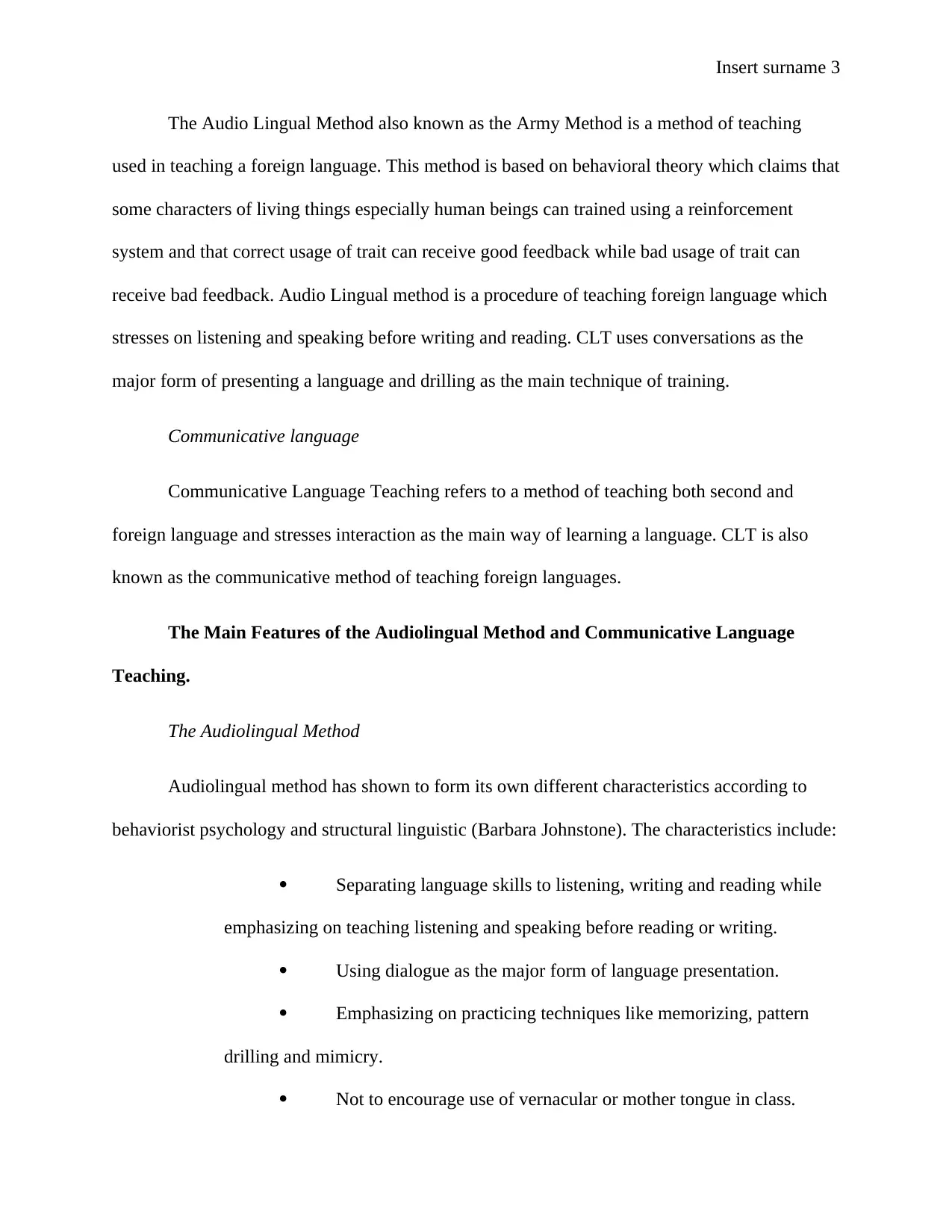
Insert surname 3
The Audio Lingual Method also known as the Army Method is a method of teaching
used in teaching a foreign language. This method is based on behavioral theory which claims that
some characters of living things especially human beings can trained using a reinforcement
system and that correct usage of trait can receive good feedback while bad usage of trait can
receive bad feedback. Audio Lingual method is a procedure of teaching foreign language which
stresses on listening and speaking before writing and reading. CLT uses conversations as the
major form of presenting a language and drilling as the main technique of training.
Communicative language
Communicative Language Teaching refers to a method of teaching both second and
foreign language and stresses interaction as the main way of learning a language. CLT is also
known as the communicative method of teaching foreign languages.
The Main Features of the Audiolingual Method and Communicative Language
Teaching.
The Audiolingual Method
Audiolingual method has shown to form its own different characteristics according to
behaviorist psychology and structural linguistic (Barbara Johnstone). The characteristics include:
Separating language skills to listening, writing and reading while
emphasizing on teaching listening and speaking before reading or writing.
Using dialogue as the major form of language presentation.
Emphasizing on practicing techniques like memorizing, pattern
drilling and mimicry.
Not to encourage use of vernacular or mother tongue in class.
The Audio Lingual Method also known as the Army Method is a method of teaching
used in teaching a foreign language. This method is based on behavioral theory which claims that
some characters of living things especially human beings can trained using a reinforcement
system and that correct usage of trait can receive good feedback while bad usage of trait can
receive bad feedback. Audio Lingual method is a procedure of teaching foreign language which
stresses on listening and speaking before writing and reading. CLT uses conversations as the
major form of presenting a language and drilling as the main technique of training.
Communicative language
Communicative Language Teaching refers to a method of teaching both second and
foreign language and stresses interaction as the main way of learning a language. CLT is also
known as the communicative method of teaching foreign languages.
The Main Features of the Audiolingual Method and Communicative Language
Teaching.
The Audiolingual Method
Audiolingual method has shown to form its own different characteristics according to
behaviorist psychology and structural linguistic (Barbara Johnstone). The characteristics include:
Separating language skills to listening, writing and reading while
emphasizing on teaching listening and speaking before reading or writing.
Using dialogue as the major form of language presentation.
Emphasizing on practicing techniques like memorizing, pattern
drilling and mimicry.
Not to encourage use of vernacular or mother tongue in class.
⊘ This is a preview!⊘
Do you want full access?
Subscribe today to unlock all pages.

Trusted by 1+ million students worldwide
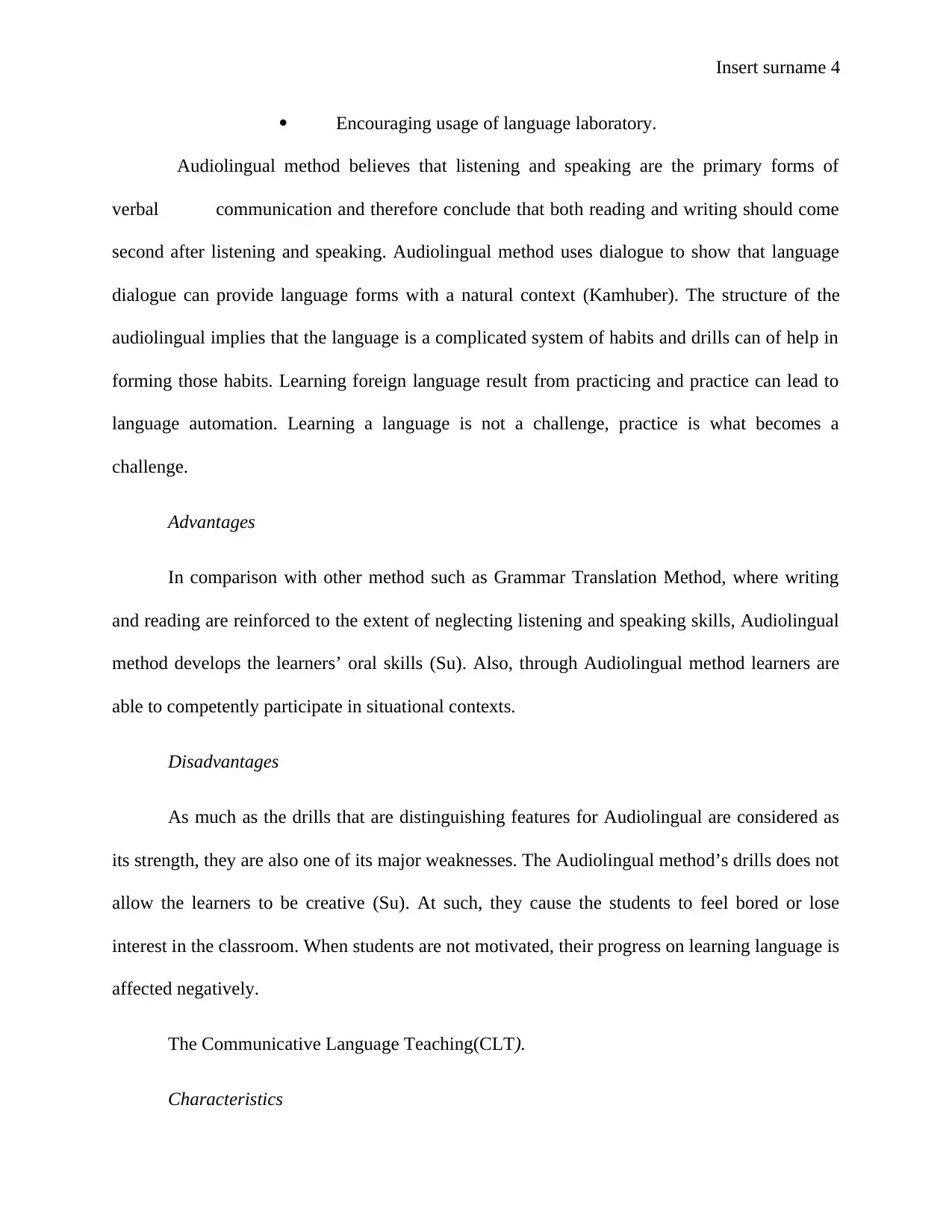
Insert surname 4
Encouraging usage of language laboratory.
Audiolingual method believes that listening and speaking are the primary forms of
verbal communication and therefore conclude that both reading and writing should come
second after listening and speaking. Audiolingual method uses dialogue to show that language
dialogue can provide language forms with a natural context (Kamhuber). The structure of the
audiolingual implies that the language is a complicated system of habits and drills can of help in
forming those habits. Learning foreign language result from practicing and practice can lead to
language automation. Learning a language is not a challenge, practice is what becomes a
challenge.
Advantages
In comparison with other method such as Grammar Translation Method, where writing
and reading are reinforced to the extent of neglecting listening and speaking skills, Audiolingual
method develops the learners’ oral skills (Su). Also, through Audiolingual method learners are
able to competently participate in situational contexts.
Disadvantages
As much as the drills that are distinguishing features for Audiolingual are considered as
its strength, they are also one of its major weaknesses. The Audiolingual method’s drills does not
allow the learners to be creative (Su). At such, they cause the students to feel bored or lose
interest in the classroom. When students are not motivated, their progress on learning language is
affected negatively.
The Communicative Language Teaching(CLT).
Characteristics
Encouraging usage of language laboratory.
Audiolingual method believes that listening and speaking are the primary forms of
verbal communication and therefore conclude that both reading and writing should come
second after listening and speaking. Audiolingual method uses dialogue to show that language
dialogue can provide language forms with a natural context (Kamhuber). The structure of the
audiolingual implies that the language is a complicated system of habits and drills can of help in
forming those habits. Learning foreign language result from practicing and practice can lead to
language automation. Learning a language is not a challenge, practice is what becomes a
challenge.
Advantages
In comparison with other method such as Grammar Translation Method, where writing
and reading are reinforced to the extent of neglecting listening and speaking skills, Audiolingual
method develops the learners’ oral skills (Su). Also, through Audiolingual method learners are
able to competently participate in situational contexts.
Disadvantages
As much as the drills that are distinguishing features for Audiolingual are considered as
its strength, they are also one of its major weaknesses. The Audiolingual method’s drills does not
allow the learners to be creative (Su). At such, they cause the students to feel bored or lose
interest in the classroom. When students are not motivated, their progress on learning language is
affected negatively.
The Communicative Language Teaching(CLT).
Characteristics
Paraphrase This Document
Need a fresh take? Get an instant paraphrase of this document with our AI Paraphraser
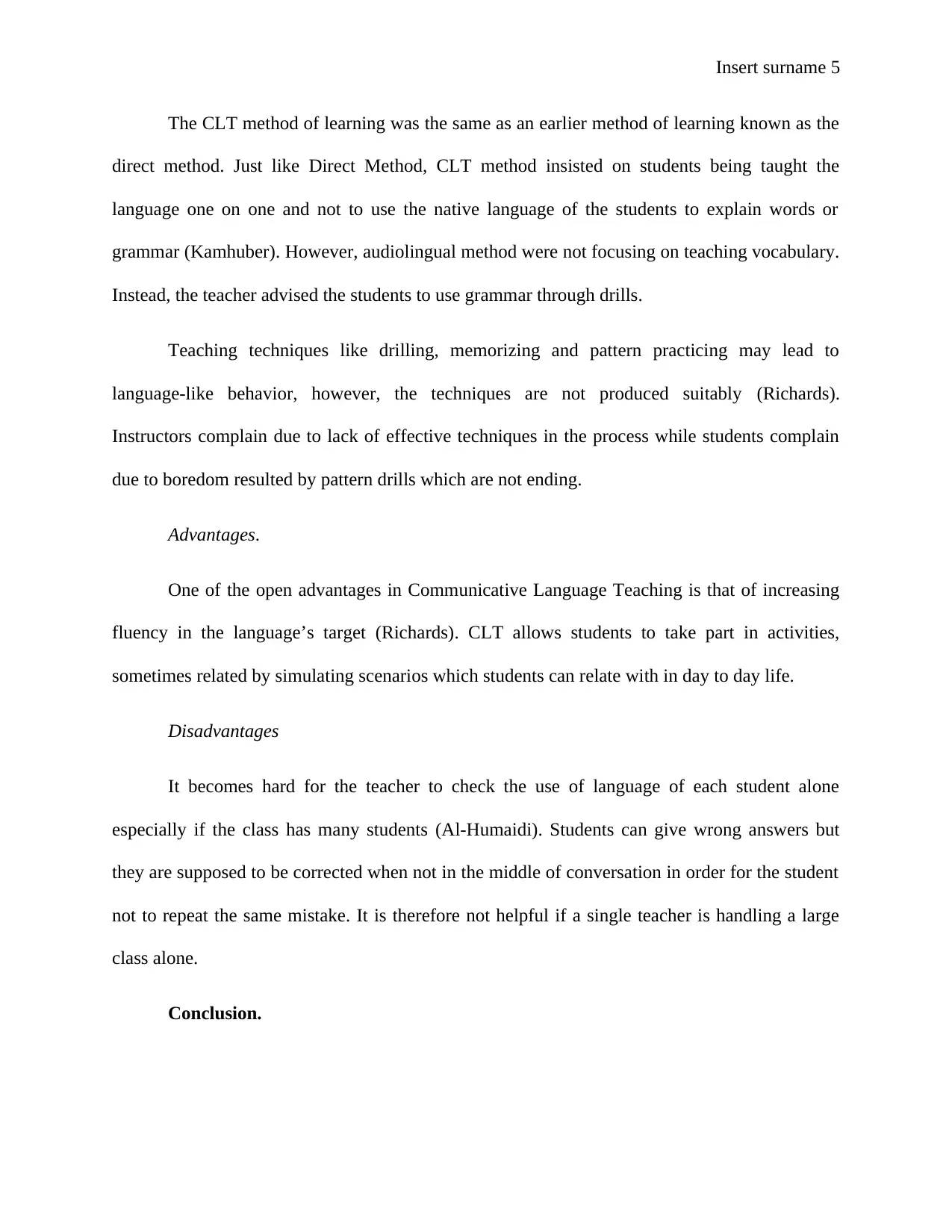
Insert surname 5
The CLT method of learning was the same as an earlier method of learning known as the
direct method. Just like Direct Method, CLT method insisted on students being taught the
language one on one and not to use the native language of the students to explain words or
grammar (Kamhuber). However, audiolingual method were not focusing on teaching vocabulary.
Instead, the teacher advised the students to use grammar through drills.
Teaching techniques like drilling, memorizing and pattern practicing may lead to
language-like behavior, however, the techniques are not produced suitably (Richards).
Instructors complain due to lack of effective techniques in the process while students complain
due to boredom resulted by pattern drills which are not ending.
Advantages.
One of the open advantages in Communicative Language Teaching is that of increasing
fluency in the language’s target (Richards). CLT allows students to take part in activities,
sometimes related by simulating scenarios which students can relate with in day to day life.
Disadvantages
It becomes hard for the teacher to check the use of language of each student alone
especially if the class has many students (Al-Humaidi). Students can give wrong answers but
they are supposed to be corrected when not in the middle of conversation in order for the student
not to repeat the same mistake. It is therefore not helpful if a single teacher is handling a large
class alone.
Conclusion.
The CLT method of learning was the same as an earlier method of learning known as the
direct method. Just like Direct Method, CLT method insisted on students being taught the
language one on one and not to use the native language of the students to explain words or
grammar (Kamhuber). However, audiolingual method were not focusing on teaching vocabulary.
Instead, the teacher advised the students to use grammar through drills.
Teaching techniques like drilling, memorizing and pattern practicing may lead to
language-like behavior, however, the techniques are not produced suitably (Richards).
Instructors complain due to lack of effective techniques in the process while students complain
due to boredom resulted by pattern drills which are not ending.
Advantages.
One of the open advantages in Communicative Language Teaching is that of increasing
fluency in the language’s target (Richards). CLT allows students to take part in activities,
sometimes related by simulating scenarios which students can relate with in day to day life.
Disadvantages
It becomes hard for the teacher to check the use of language of each student alone
especially if the class has many students (Al-Humaidi). Students can give wrong answers but
they are supposed to be corrected when not in the middle of conversation in order for the student
not to repeat the same mistake. It is therefore not helpful if a single teacher is handling a large
class alone.
Conclusion.
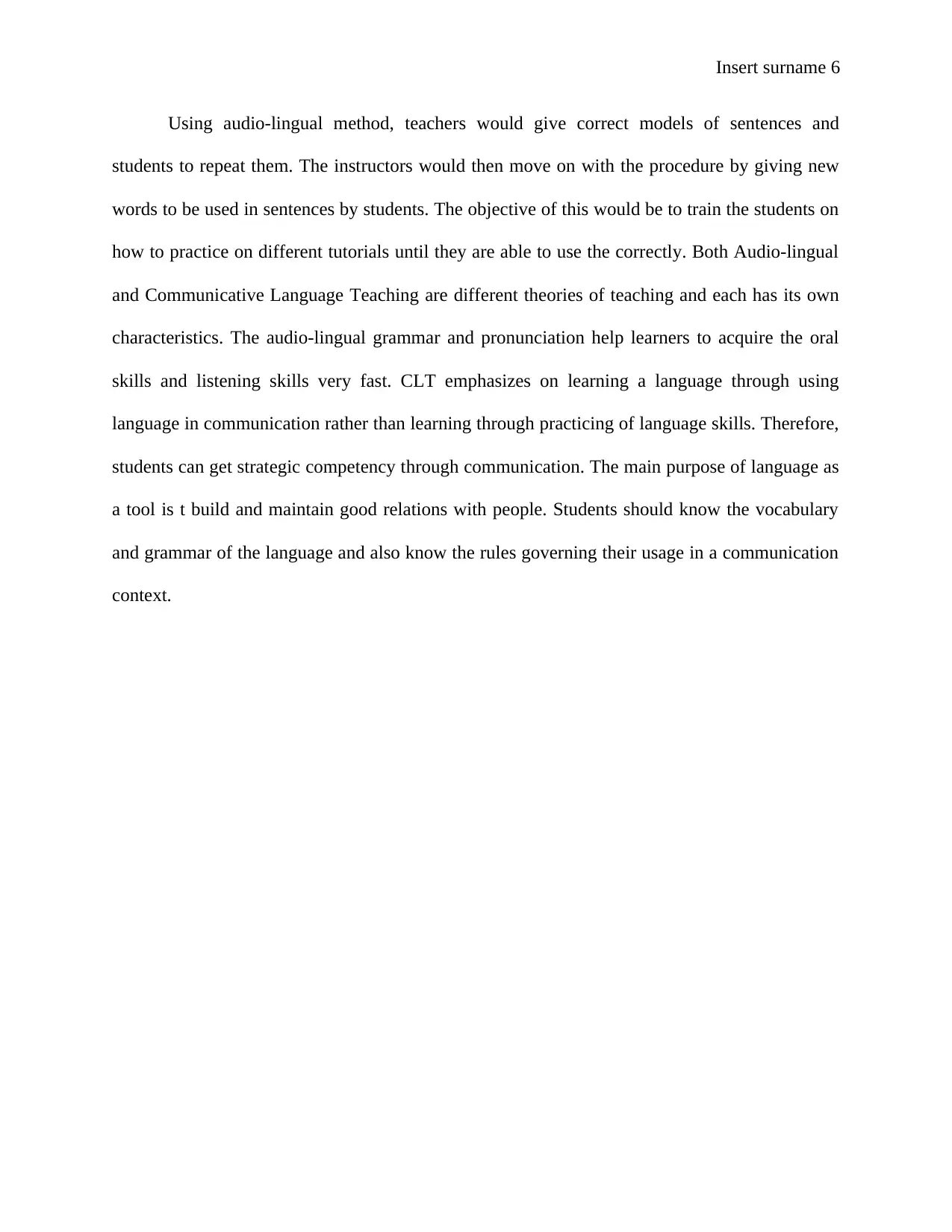
Insert surname 6
Using audio-lingual method, teachers would give correct models of sentences and
students to repeat them. The instructors would then move on with the procedure by giving new
words to be used in sentences by students. The objective of this would be to train the students on
how to practice on different tutorials until they are able to use the correctly. Both Audio-lingual
and Communicative Language Teaching are different theories of teaching and each has its own
characteristics. The audio-lingual grammar and pronunciation help learners to acquire the oral
skills and listening skills very fast. CLT emphasizes on learning a language through using
language in communication rather than learning through practicing of language skills. Therefore,
students can get strategic competency through communication. The main purpose of language as
a tool is t build and maintain good relations with people. Students should know the vocabulary
and grammar of the language and also know the rules governing their usage in a communication
context.
Using audio-lingual method, teachers would give correct models of sentences and
students to repeat them. The instructors would then move on with the procedure by giving new
words to be used in sentences by students. The objective of this would be to train the students on
how to practice on different tutorials until they are able to use the correctly. Both Audio-lingual
and Communicative Language Teaching are different theories of teaching and each has its own
characteristics. The audio-lingual grammar and pronunciation help learners to acquire the oral
skills and listening skills very fast. CLT emphasizes on learning a language through using
language in communication rather than learning through practicing of language skills. Therefore,
students can get strategic competency through communication. The main purpose of language as
a tool is t build and maintain good relations with people. Students should know the vocabulary
and grammar of the language and also know the rules governing their usage in a communication
context.
⊘ This is a preview!⊘
Do you want full access?
Subscribe today to unlock all pages.

Trusted by 1+ million students worldwide
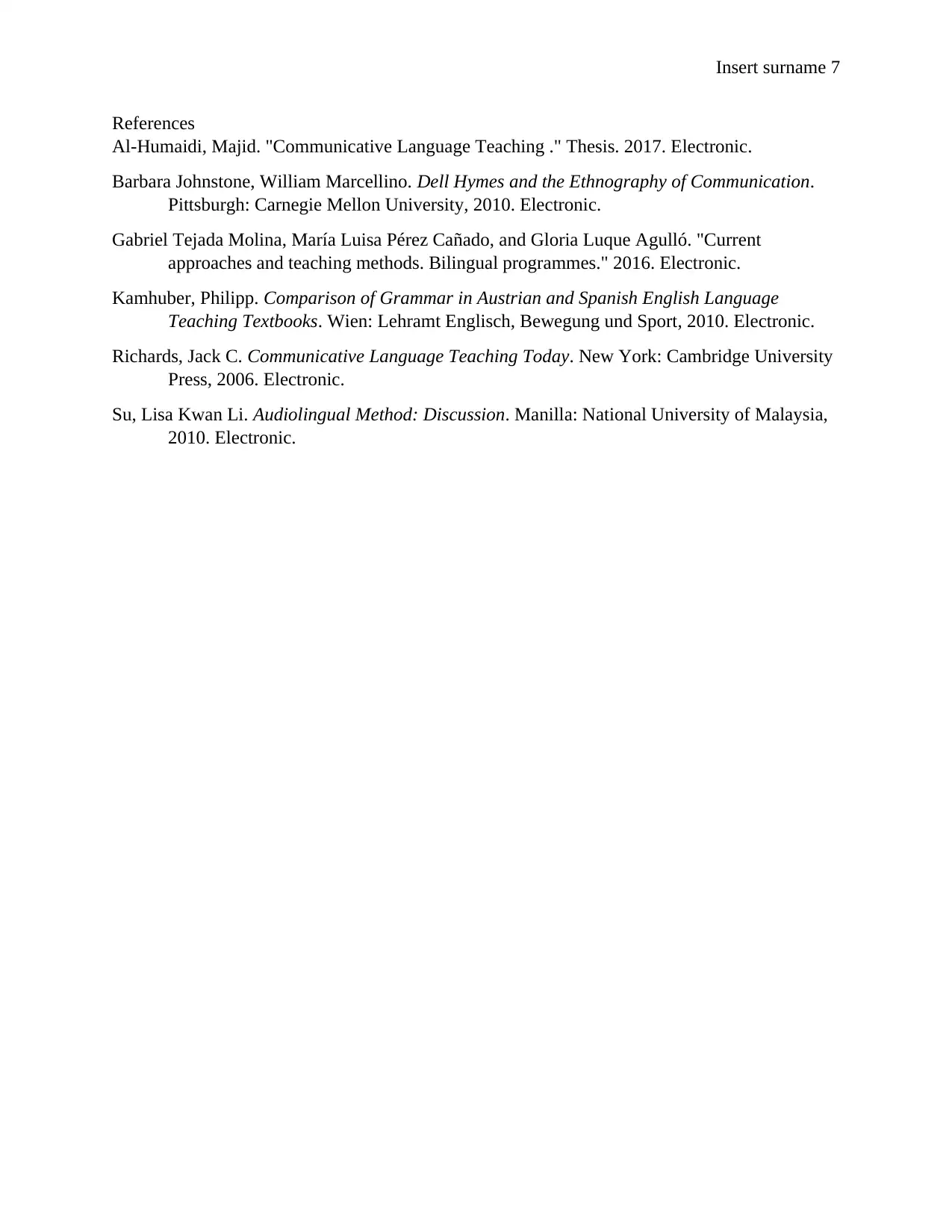
Insert surname 7
References
Al-Humaidi, Majid. "Communicative Language Teaching ." Thesis. 2017. Electronic.
Barbara Johnstone, William Marcellino. Dell Hymes and the Ethnography of Communication.
Pittsburgh: Carnegie Mellon University, 2010. Electronic.
Gabriel Tejada Molina, María Luisa Pérez Cañado, and Gloria Luque Agulló. "Current
approaches and teaching methods. Bilingual programmes." 2016. Electronic.
Kamhuber, Philipp. Comparison of Grammar in Austrian and Spanish English Language
Teaching Textbooks. Wien: Lehramt Englisch, Bewegung und Sport, 2010. Electronic.
Richards, Jack C. Communicative Language Teaching Today. New York: Cambridge University
Press, 2006. Electronic.
Su, Lisa Kwan Li. Audiolingual Method: Discussion. Manilla: National University of Malaysia,
2010. Electronic.
References
Al-Humaidi, Majid. "Communicative Language Teaching ." Thesis. 2017. Electronic.
Barbara Johnstone, William Marcellino. Dell Hymes and the Ethnography of Communication.
Pittsburgh: Carnegie Mellon University, 2010. Electronic.
Gabriel Tejada Molina, María Luisa Pérez Cañado, and Gloria Luque Agulló. "Current
approaches and teaching methods. Bilingual programmes." 2016. Electronic.
Kamhuber, Philipp. Comparison of Grammar in Austrian and Spanish English Language
Teaching Textbooks. Wien: Lehramt Englisch, Bewegung und Sport, 2010. Electronic.
Richards, Jack C. Communicative Language Teaching Today. New York: Cambridge University
Press, 2006. Electronic.
Su, Lisa Kwan Li. Audiolingual Method: Discussion. Manilla: National University of Malaysia,
2010. Electronic.
1 out of 7
Related Documents
Your All-in-One AI-Powered Toolkit for Academic Success.
+13062052269
info@desklib.com
Available 24*7 on WhatsApp / Email
![[object Object]](/_next/static/media/star-bottom.7253800d.svg)
Unlock your academic potential
Copyright © 2020–2025 A2Z Services. All Rights Reserved. Developed and managed by ZUCOL.



